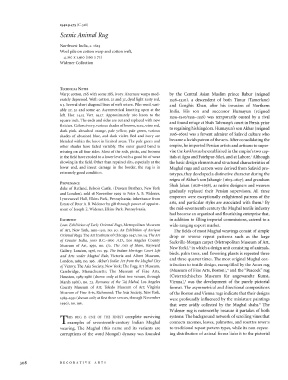Page 324 - Decorative Arts, Part II: Far Eastern Ceramics and Paintings, Persian and Indian Rugs and Carpets
P. 324
1942-9475 (C-328)
Scenic Animal Rug
Northwest India, c. 1625
Wool pile on cotton warp and cotton weft,
4.160 x 1.910 (160 x 75)
Widener Collection
TECHNICAL NOTES
Warp: cotton, z6S with some Z8S, ivory. Alternate warps mod- by the Central Asian Muslim prince Babur (reigned
erately depressed. Weft: cotton, 2Z and 3Z, dyed light rusty red, 1526-1530), a descendant of both Timur (Tamerlane)
x 3. Several short diagonal lines of weft return. Pile: wool, vari- and Genghis Khan, after his invasion of Northern
ably 2Z, 3Z and some 4Z. Asymmetrical knotting open at the India. His son and successor Humayun (reigned
left. Hor. 14,15. Vert. 19,17. Approximately 260 knots to the 1534-1540/1555-1556) was temporarily ousted by a rival
square inch. The ends and sides are cut and replaced with new
finishes. Colors: ivory, various shades of brown, ecru, wine red, and found refuge at Shah Tahmasp's court in Persia prior
dark pink, abrashed orange, pale yellow, pale green, various to regaining his kingdom. Humayun's son Akbar (reigned
shades of abrashed blue, and dark violet. Red and ivory are 1556-1605) was a fervent admirer of Safavid culture who
blended within the knot in limited areas. The pale green and became a lavish patron of the arts. After consolidating the
other shades have faded variably. The outer guard band is empire, he imported Persian artists and artisans to super-
missing on all four sides. Most of the reds, pinks, and browns vise the karkhanas he established in the empire's two cap-
1
in the field have eroded to a lower level, with a good bit of wear itals at Agra and Fatehpur-Sikri, and at Lahore. Although
showing in the field. Other than repaired slits, especially at the the basic design elements and structural characteristics of
lower end, and insect damage in the border, the rug is in Mughal rugs and carpets were derived from Safavid pro-
extremely good condition. totypes, they developed a distinctive character during the
reigns of Akbar's son Jahangir (1605-1627), and grandson
PROVENANCE Shah Jahan (1628-1658), as native designers and weavers
duke of Rutland, Belvoir Castle. (Duveen Brothers, New York
and London), sold 18 November 1909 to Peter A. B. Widener, gradually replaced their Persian supervisors. All three
Lynnewood Hall, Elkins Park, Pennsylvania; inheritance from emperors were exceptionally enlightened patrons of 2 the
Estate of Peter A. B. Widener by gift through power of appoint- arts, and particular styles are associated with them. By
ment of Joseph E. Widener, Elkins Park, Pennsylvania. the mid-seventeenth century the Mughal textile industry
had become an organized and flourishing enterprise that,
EXHIBITED in addition to filling imperial commissions, catered to a
Loan Exhibition of Early Oriental Rugs, Metropolitan Museum wide-ranging export market.
of Art, New York, 1910-1911, no. 50. An Exhibition of Antique The fields of most Mughal weavings consist of simple
Oriental Rugs, The Art Institute of Chicago, 1947, no. 14. The Art drop or reverse repeat patterns such as the large
of Greater India, 3000 B.C.-i8oo A.D., Los Angeles County Sackville-Morgan carpet (Metropolitan Museum of Art,
Museum of Art, 1950, no. 172. The Arts of Islam, Hayward New York) , in which a design unit consisting of animals,
3
Gallery, London, 1976, no. 99. The Indian Heritage: Court Life
and Arts under Mughal Rule, Victoria and Albert Museum, birds, palm trees, and flowering plants is repeated three
London, 1982, no. 196. Akbar's India: Art from the Mughal City and three-quarter times. The most original Mughal con-
of Victory, The Asia Society, New York; The Fogg Art Museum, tribution to textile design, exemplified by the Ames rug
4
Cambridge, Massachusetts; The Museum of Fine Arts, (Museum of Fine Arts, Boston), and the "Peacock" rug
Houston, 1985-1986 (shown only at first two venues, through (Osterreichisches Museum fur angewandte Kunst,
March 1986), no. 73. Romance of the Taj Mahal, Los Angeles Vienna), 5 was the development of the purely pictorial
County Museum of Art; Toledo Museum of Art; Virginia format. The asymmetrical and directional compositions
Museum of Fine Arts, Richmond; The Asia Society, New York, of the Boston and Vienna rugs indicate that their designs
1989-1991 (shown only at first three venues, through November were profoundly influenced by the miniature paintings
1990), no. 196. that were avidly collected by the Mughal shahs. 6 The
Widener rug is noteworthy because it partakes of both
HIS RUG is ONE OF THE FINEST complete surviving systems: The background network of scrolling vines that
Texamples of seventeenth-century Indian Mughal connects racemes, leaves, palmettes, and rosettes reverts
weaving. The Mughal (this name and its variants are to traditional repeat pattern types, while its non-repeat-
corruptions of the word Mongol) dynasty was founded ing distribution of animal forms links it to the pictorial
308 D E C O R A T I V E A R T S

